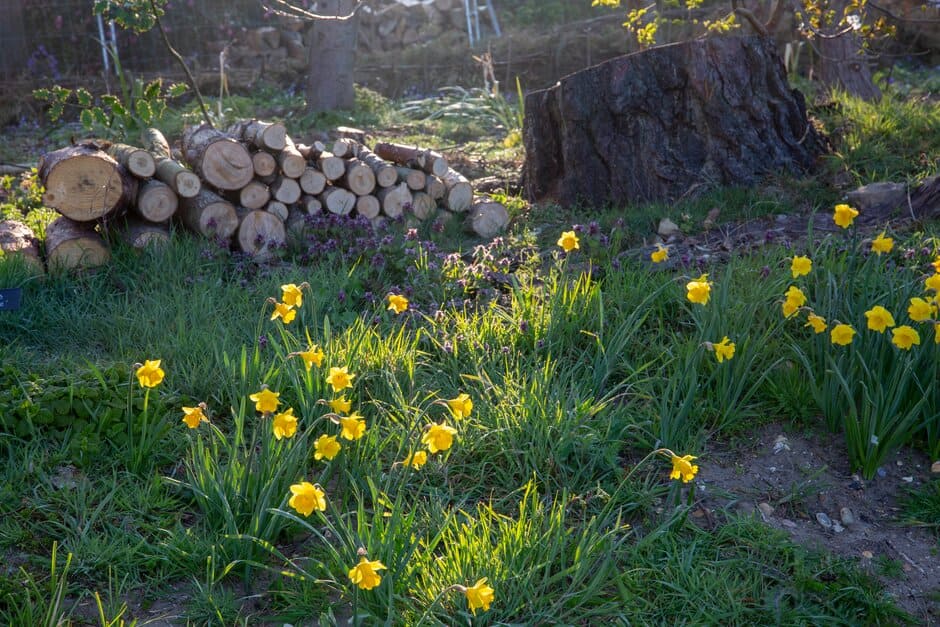How to deal with garden waste
Whether you are doing a big garden project or just regular maintenance, it’s likely you will generate some garden waste. Here are some ideas for reusing material within your garden, and some options for removing it.

Quick facts
- Given the right conditions, plant waste can be made into garden compost in as little as six months
- Making a log pile is a simple way to boost biodiversity in your garden
- Information on garden waste collection can be found on your local council’s website
- Not all garden waste is compostable – stones and soil cannot be composted, but can be reused
Getting started
Routine garden maintenance tasks, such as mowing lawns or cutting back herbaceous plants, create green waste. Projects, such as replacing a patio or removing an old conifer hedge, can generate large amounts of waste in one go. When planning a garden project, estimate how much and what type of waste will be generated. You may also need to think about where the waste can temporarily be stored.
How to reuse waste within your garden
-
Start home composting
This is an easy option for turning garden waste into useful compost. Where space is limited, consider using a ‘dalek’ bin made from recycled plastic or a HOTBIN. For more information, see our guide to composting. -
Make good use of fallen leaves
Trees and shrubs can shed huge quantities of leaves every autumn – these can be turned into leafmould, which is a useful mulch, soil improver, and potting compost ingredient.
Collect fallen leaves from lawns and paths in autumn, place them in a jute leaf sack, old compost bag or bin bag, and in about two years you will have a bag of leaf mould, often referred to as ‘black gold’. Bagged leaves don’t take up much space, but if you don’t have any space available, find another gardener locally who would like them. -
Use felled trees and pruned branches to make wood-chip mulch
Many arborists have mobile chippers and will be happy to leave you the wood-chips. Wood-chippers are also available for hire.
Wood-chips can be used as a surface for informal paths or as a mulch around established plants. When applied as a layer of mulch to the surface of soil, freshly chipped wood will not deplete the soil of nitrogen, as is sometimes feared. For more information, see our guide to using woody waste as a mulch. -
Try matchstick mulching
Cutting back ornamental grasses and herbaceous perennials in late winter/early spring coincides with the ideal time to mulch. Combining the two tasks eliminates the need to remove the plant material from your garden. With hand shears or a hedge trimmer, cut the old stems of grasses or herbaceous perennials into matchstick-length sections and spread them evenly around plants as a layer of mulch. -
Find uses for logs
Sections of logs can be used to edge pathways or borders, create seats, and provide a home for wildlife when stacked in a pile. As a precaution, it’s best to avoid repurposing wood from the base of trees infected with honey fungus or phytophthora root rot, or branches infected with coral spot or verticillium wilt. See our guide to disposing of diseased material instead. -
Mulch with grass clippings
Avoid collecting grass clippings by using a mulching lawn mower. These are rotary mowers that finely chop the clippings and deposit them straight back onto the turf, returning some nutrients to the soil and helping with moisture retention. They are effective when mowing is done regularly.
When using a normal mower it may not be necessary to collect short (less than 1cm), dry clippings. Adopt the motto ‘If it’s dry, let them fly’ and remove the collection box from your mower. Thin layers of grass clippings can also be used to mulch around established plants.
How to dispose of garden waste
-
Arrange a regular council collection
Many local councils provide kerbside collection of binned or bagged compostable garden waste. There may be an initial charge for a garden waste bin and then an annual fee for collections (often fortnightly). Collections are taken to large composting facilities, with the resulting product being used in agriculture and horticulture. -
Advertise locally
Things you want to get rid of may be exactly what another gardener needs. Topsoil, logs and paving slabs are the type of items advertised free for collection on local social media groups or organisations like Freecycle. -
Take a trip to the tip
Local recycling centres have designated areas for green/garden waste. The waste will be transported to large-scale composting facilities. -
Hire a skip
This is a good option if you are likely to produce a lot of waste in quite a short space of time. Paying for waste to be taken away, in a skip or by a reputable waste clearance company, might be a suitable option for garden clearance projects.
Get involved
The Royal Horticultural Society is the UK’s leading gardening charity. We aim to enrich everyone’s life through plants, and make the UK a greener and more beautiful place.